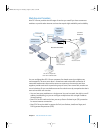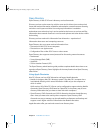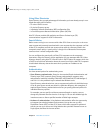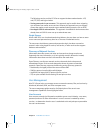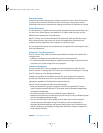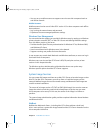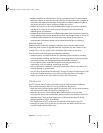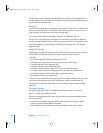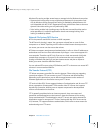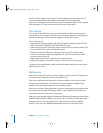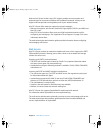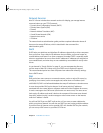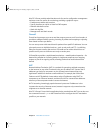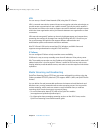
Chapter 2 Inside Mac OS X Server 35
• NetBoot simplifies the administration of large-scale deployments of network-based
Macintosh systems or racks of Xserves. It’s ideal for an organization with a number of
computers that need to be identically configured; for example, NetBoot can offer a
web service provider a way to configure multiple web servers.
• NetBoot also lets you set up multiple NetBoot disk images, so you can boot clients
into Mac OS 9 or Mac OS X or even customize the Macintosh environment for
different groups of computers.
• NetBoot allows administrators to configure and update client computers instantly by
simply updating a boot image stored on the server. Any changes made on the server
are automatically reflected on the clients when they reboot. Systems that are
compromised or otherwise altered can be instantly restored just by rebooting.
Network Install
Network Install is a centrally managed installation service that lets administrators
selectively install, restore, or upgrade Macintosh computers. You don’t have to insert
multiple CDs to set up a system; all the installation data resides on the server.
Here are some of the advantages that Network Install offers:
• Network Install is an excellent solution for operating system migrations, installing
software updates, installing site-licensed or custom applications, restoring computer
classrooms and labs, and reimaging desktop and portable computers.
• You can define custom installation images for various departments in an
organization, such as marketing, engineering, and sales.
• You can define post-installation scripts that invoke actions after the installation of a
software package or system image.
• You can set up an automated install image. This type of image includes answers to all
of the usual installer questions so that when the client boots from the image, it
installs its contents on the client machine without user intervention.
File Services
Mac OS X Server makes it easy to share files using the native protocols of different
kinds of client computers. Mac OS X Server includes four file services:
• Apple file service, which uses the Apple Filing Protocol (AFP), lets you share resources
with clients who use Mac OS 8, Mac OS 9, and Mac OS X.
• Windows services use Server Message Block (SMB) protocol to let you share
resources with clients who use Windows, and to provide name resolution service for
Windows clients. These services support users of Microsoft Windows 95, 98, ME
(Millennium Edition), XP, NT 4.0, and 2000.
• File Transfer Protocol (FTP) service lets you share files with anyone using FTP.
• Network File System (NFS) service lets you share files and folders with users who
have NFS client software (UNIX users).
LL2343.Book Page 35 Thursday, August 14, 2003 5:12 PM



